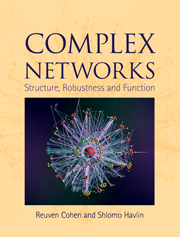Book contents
- Frontmatter
- Contents
- 1 Introduction
- PART I RANDOM NETWORK MODELS
- PART II STRUCTURE AND ROBUSTNESS OF COMPLEX NETWORKS
- PART III NETWORK FUNCTION: DYNAMICS AND APPLICATIONS
- 13 Optimization of the network structure
- 14 Epidemiological models
- 15 Immunization
- 16 Thermodynamic models on networks
- 17 Spectral properties, transport, diffusion and dynamics
- 18 Searching in networks
- 19 Biological networks and network motifs
- Appendix A Probability theoretical methods
- Appendix B Asymptotics and orders of magnitude
- Appendix C Algorithms for network simulation and investigation
- References
- Index
13 - Optimization of the network structure
from PART III - NETWORK FUNCTION: DYNAMICS AND APPLICATIONS
Published online by Cambridge University Press: 05 August 2013
- Frontmatter
- Contents
- 1 Introduction
- PART I RANDOM NETWORK MODELS
- PART II STRUCTURE AND ROBUSTNESS OF COMPLEX NETWORKS
- PART III NETWORK FUNCTION: DYNAMICS AND APPLICATIONS
- 13 Optimization of the network structure
- 14 Epidemiological models
- 15 Immunization
- 16 Thermodynamic models on networks
- 17 Spectral properties, transport, diffusion and dynamics
- 18 Searching in networks
- 19 Biological networks and network motifs
- Appendix A Probability theoretical methods
- Appendix B Asymptotics and orders of magnitude
- Appendix C Algorithms for network simulation and investigation
- References
- Index
Summary
In this chapter we present results for the robustness of complex networks under multiple waves of simultaneous targeted attacks in which the highest degree nodes are removed and random attacks (or failures), in which fractions pt and pr, respectively, of the nodes are removed until the network collapses [TPC+05]. It is shown that the network design, which optimizes network robustness, has a bimodal degree distribution, with a fraction r of the nodes having degree k2 = ( k − 1 + r)/r and the remainder of the nodes having degree k1 = 1, where k is the average degree of all the nodes. The optimal value of r approaches pt/pr for pt/pr ≪ 1.
Introduction
The resilience of real-world networks to random attacks or to attacks targeted at the highest degree nodes is of much interest [AJB00, CEbH00, CEbH01, CNSW00, Pax97, PSS05, VSS04]. Many real-world networks are robust to random attacks but vulnerable to targeted attacks on the most important nodes. It is important to understand how to design networks that are optimally robust against both types of attacks, with examples being terrorist attacks on physical networks and attacks by hackers on computer networks. In Chapter 10 we considered the case in which there was only one type of attack on a given network, that is, the network was subject to either a random attack or to a targeted attack but not subject to different types of attack simultaneously, which is a more realistic scenario.
- Type
- Chapter
- Information
- Complex NetworksStructure, Robustness and Function, pp. 145 - 153Publisher: Cambridge University PressPrint publication year: 2010



